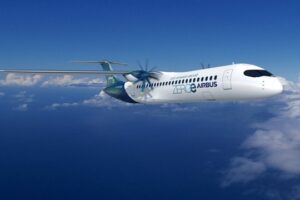
(Airbus hydrogen-powered aircraft rendering. Photo: Airbus/Zuma Press)
About five years ago, Airbus made a bold bet: The plane maker would launch a zero-emissions, hydrogen-powered aircraft within 15 years that, if successful, would mark the biggest revolution in aviation technology since the jet engine, the WSJ’s Benjamin Katz reports.
The plan raised eyebrows because the technical challenges of the way they were going to do this were huge. Engines would need to be reconfigured to run on hydrogen which would need to be stored in liquid form at minus 423 degrees F. The heavier fuel load and equipment would reduce both seat capacity and range. And then there were the safety concerns exemplified by the 1937 Hindenburg disaster.
The company settled on hydrogen-fuel cells to generate energy for electric motors. But fuel cells are extremely heavy, and the plan required a radical redesign of the airframe and propulsion system which would carry only 100 passengers about 1,000 nautical miles. Plus, as the picture here shows, it is a propeller driven design, so it is certainly not going to fly as fast meaning passengers are going to find their flights longer. This is all just wrong.
The company has spent more than $1.7 billion on the project, according to people familiar with the matter, and over the past year they concluded that technical challenges and a slow uptake of hydrogen in the wider economy meant the jet wouldn’t be ready by 2035. Notice they also failed to admit that hydrogen was going to cost them more than conventional aviation fuel. This was greenwashing at its best, and a complete lack of fiduciary responsibility on the part of senior leadership.
But I blame the scientific and engineering community who knew better. The whole idea was just wrong-headed. That is, until you look at their motivation as the article points out:
“Airbus also had a commitment to a major shareholder—the French state. The company had been a major beneficiary of a Covid-era government support package for the aviation and aerospace sector of 15 billion euros, equivalent to roughly $16.6 billion. The deal required Airbus to spend a portion of the money on bringing green aircraft to market by the 2030s.”
That’s all you need to know. $1.7 billion looks like a small fee to get back $16 billion! Greenwashing at its best … always follow the money!
2 thoughts on “Greenwashing Indulgences”
Comments are closed.
Follow the money is always a common thread in almost every business endeavors l.
Come to California, Greenwashing at its finest here!!